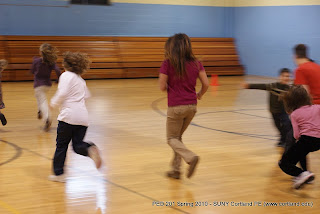



This week at St. Mary's the theme during our games was hopping, galloping and running. We tried to incorporate these skills into the games that we used with the children. We began by watching the children participate in games hosted by other groups, while evaluating the movement and behavior of one particular boy and girl. I did not see any clear pattern of development between the two children; they both seemed to respond to the new skills almost the same. Both children hopped on one foot equally well, but did need time every few hops to land on two feet. The boy and girl had a little trouble galloping, both did almost a run rather then a gallop. The running looked to be pretty well off for both the children. At the end of evaluating the children my group and I had to introduce our games. Some of the games were a bit too much for the children, and we had to explain the game a few more times then usual. We played two tag games, and then went to the cafeteria. I sat at the end of a table with about 6 or 7 girls, who were all coloring pictures. I offered to draw anything they wanted for them to color, and after one Hello Kitty drawing I ended up making every girl one. The drawing went over great, and I was happy to see that the children all wanted one of my pictures. All of the children in the cafeteria were pretty controlled, except for when we had the children pick up which got a rowdy. They had to be told to stay in a line after they picked up their things a few times by all of my group members. When going back to the gymnasium, it was my turn to introduce a game. I gathered the children to the center circle, and asked if anyone had heard the game " What time is it Mr. Fox" and the children started screaming in excitement. I asked for two helpers, and then told the children to go to one end of the gymnasium while me and the two helpers stood at the opposite end. I waited for the children to yell down " What time as it Mr. Fox", and would only respond if the children were really excited and yelling down to me. If they weren't really yelling, I would tell them that I couldn't hear them and also wouldn't give them a time until they got louder. I tried to incorporate the new skills into my game each round of the game, I would have them hop and gallop back to safety. I enjoyed my time with the children today, and loved the feedback I got from the children with my tag game and my Hello Kitty pictures.


